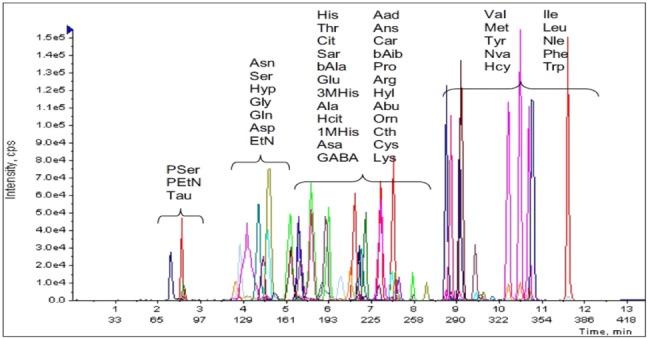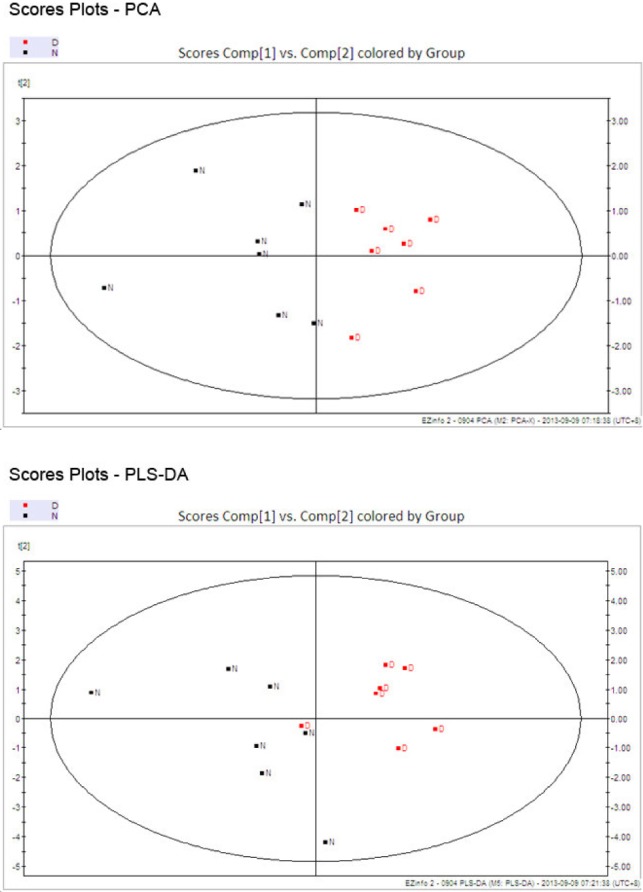Korean J Physiol Pharmacol.
2014 Oct;18(5):371-376. 10.4196/kjpp.2014.18.5.371.
Alterations of Amino Acid Level in Depressed Rat Brain
- Affiliations
-
- 1School of Chinese Materia Medica, Beijing University of Chinese Medicine, Beijing, P.R. China 100029. njtcm@263.net
- KMID: 2285534
- DOI: http://doi.org/10.4196/kjpp.2014.18.5.371
Abstract
- Amino-acid neurotransmitter system dysfunction plays a major role in the pathophysiology of depression. Several studies have demonstrated the potential of amino acids as a source of neuro-specific biomarkers could be used in future diagnosis of depression. Only partial amino acids such as glycine and asparagine were determined from certain parts of rats' brain included hippocampi and cerebral cortex in previous studies. However, according to systematic biology, amino acids in different area of brain are interacted and interrelated. Hence, the determination of 34 amino acids through entire rats' brain was conducted in this study in order to demonstrate more possibilities for biomarkers of depression by discovering other potential amino acids in more areas of rats' brain. As a result, 4 amino acids (L-aspartic acid, L-glutamine, taurine and gamma-amino-n-butyric acid) among 34 were typically identified as potentially primary biomarkers of depression by data statistics. Meanwhile, an antidepressant called Fluoxetine was employed to verify other potential amino acids which were not identified by data statistics. Eventually, we found L-alpha-amino-adipic acid could also become a new potentially secondary biomarker of depression after drug validation. In conclusion, we suggested that L-aspartic acid, L-glutamine, taurine, gamma-amino-n-butyric acid and L-alpha-amino-adipic acid might become potential biomarkers for future diagnosis of depression and development of antidepressant.
MeSH Terms
Figure
Reference
-
1. Keck ME. Corticotropin-releasing factor, vasopressin and receptor systems in depression and anxiety. Amino Acids. 2006; 31:241–250. PMID: 16733617.
Article2. Frazer A, Morilak DA. What should animal models of depression model? Neurosci Biobehav Rev. 2005; 29:515–523. PMID: 15893377.
Article3. Katz RJ. Animal model of depression: effects of electroconvulsive shock therapy. Neurosci Biobehav Rev. 1981; 5:273–277. PMID: 7196558.
Article4. Katz RJ. Animal model of depression: pharmacological sensitivity of a hedonic deficit. Pharmacol Biochem Behav. 1982; 16:965–968. PMID: 7202217.
Article5. Katz RJ, Baldrighi G. A further parametric study of imipramine in an animal model of depression. Pharmacol Biochem Behav. 1982; 16:969–972. PMID: 7202218.
Article6. Yoon SH, Kim BH, Ye SK, Kim MH. Chronic non-social stress affects depressive behaviors but not anxiety in mice. Korean J Physiol Pharmacol. 2014; 18:263–268. PMID: 24976767.
Article7. Bennett GS, Edelman GM. Amino acid incorporation into rat brain proteins during spreading cortical depression. Science. 1969; 163:393–395. PMID: 5762776.
Article8. Johnson ES, Roberts MH, Straughan DW. Amino-acid induced depression of cortical neurones. Br J Pharmacol. 1970; 38:659–666. PMID: 5445689.
Article9. Farkas T, Dunner DL, Fieve RR. L-tryptophan in depression. Biol Psychiatry. 1976; 11:295–302. PMID: 779855.10. Branchey L, Branchey M, Shaw S, Lieber CS. Relationship between changes in plasma amino acids and depression in alcoholic patients. Am J Psychiatry. 1984; 141:1212–1215. PMID: 6486254.11. Jang HJ, Cho KH, Park SW, Kim MJ, Yoon SH, Rhie DJ. Effects of serotonin on the induction of long-term depression in the rat visual cortex. Korean J Physiol Pharmacol. 2010; 14:337–343. PMID: 21165334.
Article12. Bellodi L, Erzegovesi S, Bianchi L, Lucini V, Conca R, Lucca A. Plasma tryptophan levels and tryptophan/neutral amino acid ratios in obsessive-compulsive patients with and without depression. Psychiatry Res. 1997; 69:9–15. PMID: 9080540.
Article13. Pan Y, Hong Y, Zhang QY, Kong LD. Impaired hypothalamic insulin signaling in CUMS rats: restored by icariin and fluoxetine through inhibiting CRF system. Psychoneuroendocrinology. 2013; 38:122–134. PMID: 22663897.
Article14. Li Y, Xu LL, Ruan JX, Zhang ZQ. Research progress of enhancing quantitative sensitivity by using LC-MS(n) with derivatization method in bio-matrices. Yao Xue Xue Bao. 2011; 46:637–641. PMID: 21882522.15. Küçükibrahimoğlu E, Saygin MZ, Calişkan M, Kaplan OK, Unsal C, Gören MZ. The change in plasma GABA, glutamine and glutamate levels in fluoxetine- or S-citalopram-treated female patients with major depression. Eur J Clin Pharmacol. 2009; 65:571–577. PMID: 19373461.
Article16. McEwen AM, Burgess DT, Hanstock CC, Seres P, Khalili P, Newman SC, Baker GB, Mitchell ND, Khudabux-Der J, Allen PS, LeMelledo JM. Increased glutamate levels in the medial prefrontal cortex in patients with postpartum depression. Neuropsychopharmacology. 2012; 37:2428–2435. PMID: 22805604.
Article17. Haas HL, Hösli L. The depression of brain stem neurones by taurine and its interaction with strychnine and bicuculline. Brain Res. 1973; 52:399–402. PMID: 4700718.
Article18. Toyoda A, Iio W. Antidepressant-like effect of chronic taurine administration and its hippocampal signal transduction in rats. Adv Exp Med Biol. 2013; 775:29–43. PMID: 23392922.
Article19. Bellance N, Pabst L, Allen G, Rossignol R, Nagrath D. Oncosecretomics coupled to bioenergetics identifies alpha-amino adipic acid, isoleucine and GABA as potential biomarkers of cancer: Differential expression of c-Myc, Oct1 and KLF4 coordinates metabolic changes. Biochim Biophys Acta. 2012; 1817:2060–2071. PMID: 22842522.20. Gelenberg AJ, Wurtman RJ. L-tyrosine in depression. Lancet. 1980; 2:863–864. PMID: 6107536.
Article23. Mouret J, Lemoine P, Minuit MP, Robelin N. L-tyrosine cures, immediate and long term, dopamine-dependent depressions. Clinical and polygraphic studies. C R Acad Sci III. 1988; 306:93–98. PMID: 3126995.
- Full Text Links
- Actions
-
Cited
- CITED
-
- Close
- Share
- Similar articles
-
- Amino Acid Transporters as Potential Therapeutic Targets in Thyroid Cancer
- The Effects of Repeated Toluene Exposure on Amino Acid Neurotransmitters in the Rat Brain
- Amino Acid Derangements in Plasma and Erythrocytes of Patients with Sepsis
- The ontogeny of excitatory amino acid receptors in the rat brain quantitative autoradiographic study: I. N-methyl-D-aspartate receptors
- Differential Expression of System L Amino Acid Transporters in Wound Healing Process of Rat Skin



